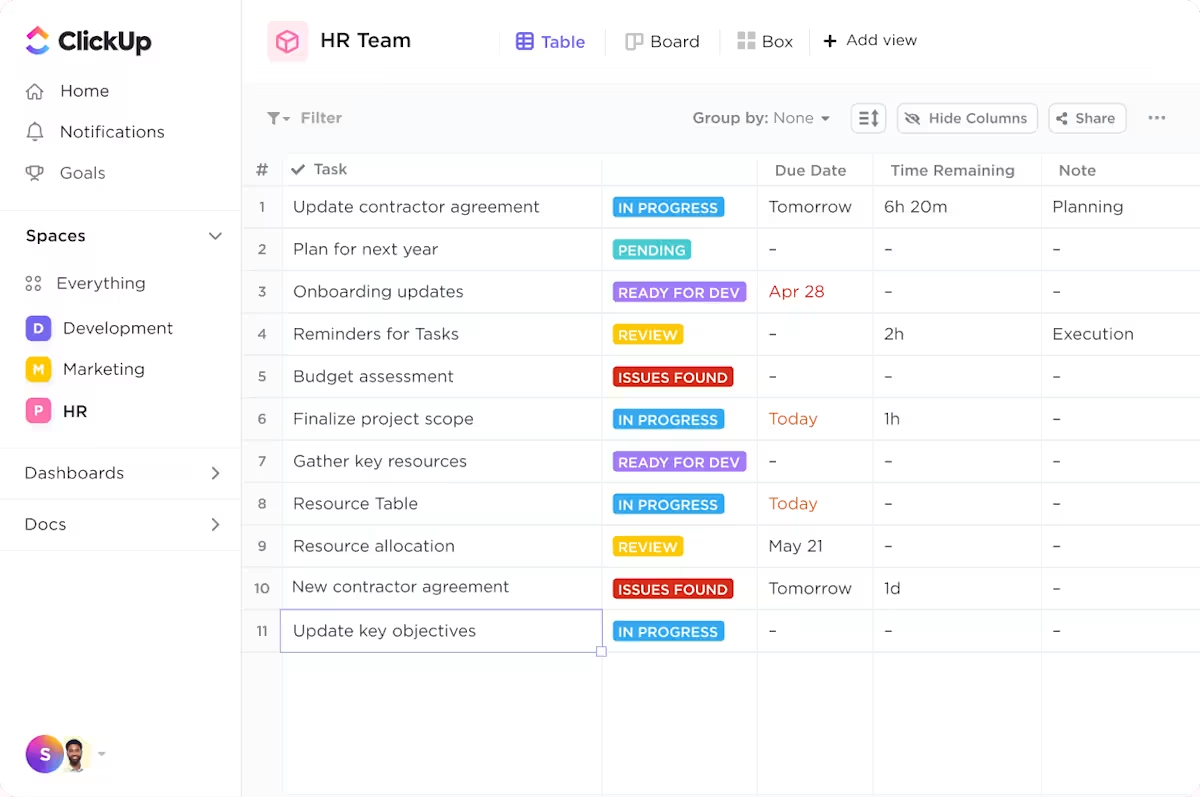You lose a team member and think, “Could we have done something to keep them?” That is the primary question that separates regrettable vs. non-regrettable termination
And unfortunately, it’s one HR leaders don’t ask often enough. When employees leave, it’s not always a red flag. But when the right ones walk away, it signals something deeper than just a role mismatch or a better offer.
You might notice:
- A dip in employee engagement after a high performer exits
- Your remaining employees quietly adjusting to heavier workloads
- Managers scrambling to preserve team culture mid-quarter
The issue isn’t just about employee turnover, it’s knowing which exits are preventable, and which are overdue. That’s where this distinction helps you lead better, retain longer, and hire smarter.
Most companies focus on the number of exits. The smart ones focus on which exits they can’t afford.
⏰ 60-Second Summary
Not all employee exits are the same and understanding the difference is essential for building resilient, high-performing teams.
- Use the regrettable vs. non-regrettable termination framework to identify which exits hurt your business and which help it move forward
- Avoid common pitfalls by tracking attrition rates, recognizing early disengagement signals, and aligning decisions with performance data
- Reduce regretted attrition with structured feedback, career development opportunities, and smart retention workflows
- Empower HR teams with to manage everything from employee data to offboarding documentation and engagement surveys in one place
- Build a culture where the right people stay and every exit leaves you stronger, not behind
Centralize your retention and termination strategy, from tasks to templates and everything in between.
Regrettable vs. Non-Regrettable Termination: Differences & Best Practices
What Is Employee Termination?
Employee termination marks the end of an employee’s formal relationship with a company. It’s not always dramatic, but it’s always a turning point. Whether it’s a resignation from a top performer or a structured exit for an underperformer, every termination leaves a footprint on your company, your employee data, and your ability to retain the right talent.
Understanding how these exits play out helps HR teams reduce unwanted employee turnover, maintain a strong workplace culture, and make more strategic staffing decisions.
Common reasons for termination
Terminations happen for all kinds of reasons and not all of them are under your organization’s control. But each one impacts your attrition rates, morale, and even long-term cost savings.
Here are some of the most common causes:
- Lack of performance: When expectations are consistently missed, and coaching doesn’t drive improvement
- Cultural misalignment: The employee may have the skills, but their values or behaviors don’t align with the company/ This can have a detrimental effect on other team members and overall performance
- Misconduct or violations: Breaches of company policy, ethical standards, or workplace behavior norms
- Business restructuring: Layoffs due to mergers, budget cuts, or changes in direction and not necessarily due to performance
- Career changes: Employees leaving for better career development, growth opportunities, or improved work-life balance
- Burnout and dissatisfaction: When valued employees leave due to unclear roles, lack of recognition, or insufficient feedback loops
Some exits are avoidable with the right retention strategies. Others are necessary to protect performance, culture, or direction.
Voluntary vs. involuntary termination
Here’s a breakdown to help you distinguish between voluntary and involuntary terminations and what they reveal about your organization:
| Criteria | Voluntary termination | Involuntary termination |
| Who initiates | Employee | Employer |
| Typical reasons | Career switch, relocation, burnout, lack of career growth, dissatisfaction with employee experience or job satisfaction, better offer | Poor performance, behavior issues, policy violations, downsizing, toxic company culture |
| Impact on company | This can result in regrettable attrition if high performers or valuable employees leave unexpectedly | Often seen as non-regretted attrition, but if overused, may signal poor hiring or weak performance management |
| What it signals | Gaps in employee retention, lack of support for career growth, or disengagement | Need for better hiring, training, or addressing underlying cultural issues |
| Common HR response | Improve communication tools, offer career path clarity, redesign workloads, check employee satisfaction | Audit performance processes, conduct thorough exit interviews, align policies, monitor HR metrics |
Voluntary doesn’t always mean positive. Involuntary doesn’t always mean bad. The key is tracking what patterns emerge, and whether you’re losing great employees or filtering out the wrong fits.
👀 Did You Know? Employees who leave a company and then get rehired are called boomerang employees. They often outperform new hires because they already understand the company’s culture and processes.
Key Differences Between Regrettable and Non-Regrettable Termination: At a Glance
Before we go into the details of what each type of termination means, here’s a quick snapshot of the differences between regrettable vs. non-regrettable termination.
Some departures slow you down. Others give you room to breathe. Recognizing the difference helps your team focus on what truly matters: retaining those you can’t afford to lose, and confidently letting go of those who aren’t moving your business forward.
| Criteria | Regrettable termination | Non-regrettable termination |
| Definition | The loss of a high-performing, culturally aligned employee you wanted to retain | The exit of an employee whose performance or fit was not adding value |
| Impact on team | Creates disruption, knowledge gaps, and reduced morale among existing employees | Often improves team dynamics and reduces friction |
| Cost to the company | High; lost intellectual capital, recruiting costs, delayed projects | Low; often frees up budget or creates cost savings |
| Signal to leadership | Gaps in employee retention, career development, or support systems | Effective use of HR metrics to maintain performance standards |
| Typical root causes | Burnout, lack of professional growth, poor work-life balance, unaddressed feedback | Chronic poor performance, cultural misalignment, lack of engagement |
| Rehire likelihood | Yes, most companies would rehire if given the chance | No, typically seen as unregretted attrition |
| Best response | Review retention strategies, run thorough exit interviews, assess team health | Audit performance policies, track unregretted attrition rate, support remaining team members |
| Long-term effect | Weakens company culture and increases turnover risk if patterns continue | Strengthens team alignment and reinforces accountability |
Most HR professionals don’t get tripped up by the number of exits. The challenge is knowing which exits signal trouble and which ones show your systems are working.
When you understand the core differences between regrettable vs non-regrettable attrition, your hiring, development, and engagement strategies become more targeted, and your teams more resilient.
And now, let’s dive into the details.
What Is Regrettable Termination?
Regrettable termination refers to the voluntary or preventable exit of an employee whose contributions, performance, or potential made them an asset to the company.
Regrettable termination is a major staffing inconvenience. But more than that, these are the people others leaned on. Typically, they include your top performers, team mentors, and culture builders. When they leave, you’re left trying to recover lost momentum, employee engagement, and internal trust.
Unlike routine employee turnover, regrettable attrition is the kind that makes you pause and wonder: could this have been avoided?
Examples of regrettable termination
You can usually feel the loss when it happens and not just on paper.
- Thinks of a high-potential product lead who exits after months of being promised a career development plan that never arrives
- A data analyst hands in their notice after consistent overtime with no recognition or growth opportunities
- A senior engineer quits because their request for flexible working schedules was declined despite warning signs of team-wide burnout
- A marketing strategist resigns after being excluded from leadership meetings and lacking clear professional growth paths
Each of these exits represents regretted attrition, the kind that leaves behind more than just an empty seat. You lose intellectual capital, project continuity, and the very people who help retain others.
And when valued employees leave, it sends a signal. Not just to leadership, but to your existing employees who start wondering if they’re next.
Why is regrettable termination a concern for businesses?
When regrettable attrition occurs, it cuts deeper than you think.
- Team morale dips: The remaining workload falls on fewer team members, often leading to exhaustion or resentment
- Reputation takes a hit: Word can spread fast both internally and externally that your company culture doesn’t retain its best
- Costs escalate: Between hiring, onboarding, lost productivity, and delayed deliverables, it’s a fast drain on cost savings
- Strategy misfires: A rising regretted attrition rate signals missed blind spots in role clarity, job satisfaction, or employee experience
If you don’t take action, it snowballs and eventually impacts performance, retention, and your ability to attract top talent.
How to reduce regrettable employee turnover?
You can’t stop all exits, but you can make sure you’re not losing the ones who matter most.
Here’s what helps:
- Run consistent one-on-one meetings: Create space for real conversations about challenges, blockers, and career direction
- Build career development into daily workflows: Don’t wait for annual reviews. IKntegrate progress tracking and mentorship check-ins regularly
- Listen to employee data: Use survey responses, engagement signals, and participation rates to flag disengaged employees early
- Support career growth with action, not just promises: Roadmap promotions, enable internal mobility, and recognize wins in real-time
- Offer flexibility without red tape: Flexible working schedules aren’t perks—they’re expectations for today’s top talent
- Use retention strategies tailored to your workforce: Different teams need different levers like using pulse surveys to design what actually sticks
To prevent regrettable attrition, you need to anticipate it and not respond after it’s too late. The right tools, structure, and culture make the difference between staying and sending that resignation email.
What Is Non-Regrettable Termination?
Non-regrettable termination refers to the departure of an employee whose exit does not disrupt business operations, team morale, or future performance. In some cases, it may even improve them.
These exits are intentional and, more importantly, necessary. They often reflect a decision to maintain standards, protect workplace culture, and align talent with long-term goals. Unlike regrettable attrition, you don’t question whether they should have stayed—you know the team is better off without them.
And when tracked accurately, non-regrettable attrition helps separate productive departures from costly ones.
Examples of non-regrettable termination
When these employees leave, the impact is either not felt at all, meaning they didn’t bring much to the table, or the impact is positive, meaning their exit brought positive changes.
- A content writer with consistently poor performance is let go after months of missed deadlines, failure to adhere to content guidelines, and ignored feedback
- A department leader known for passive-aggressive behavior, lack of vision, and poor communication quietly exits after failing to improve despite HR involvement
- An operations analyst resigns due to a lack of fit, and team productivity increases in their absence
- A junior associate’s role is eliminated during reorganization, and their responsibilities are easily absorbed by existing employees
Non-regrettable termination includes all forms of unregretted attrition, like departures that reduce overhead, ease collaboration, improve the workplace culture and environment, and make space for new hires who are better aligned with your team’s goals.
They’re also reminders that not all employee departures are setbacks. Some are progress.
When non-regrettable termination is necessary
Keeping someone who repeatedly misses the mark or disrupts others while doing so, comes at a cost. Not just in output, but in energy, trust, and culture.
That’s when non-regretted attrition becomes a strategic move.
You may need to take action when:
- Coaching stops working: Despite clear expectations and structured feedback, the employee continues to underperform
- Culture takes a hit: Their actions, however subtle or overt, erode team trust or contradict your values
- Morale starts slipping: Other team members feel burdened, unmotivated, or uncomfortable working alongside them
- No visible growth: There’s no sign of curiosity, learning, or initiative—just the same issues, on repeat
Handled proactively, these exits support better team dynamics and make your employee retention efforts more meaningful. They also give you cleaner data: distinguishing true regretted attrition from exits that improve your overall organization’s control and momentum.
Tracking your unregretted attrition rate doesn’t mean celebrating every departure—it means knowing which exits were the right ones.
👀 Did You Know? Companies don’t just run exit interviews anymore; they’re also holding stay interviews with top performers to find out what’s working.
It’s one of the smartest ways to prevent regrettable attrition before it even starts.
Managing Attrition: How Can Help and Best Practices
Managing regrettable vs non-regrettable termination effectively means having systems in place before the resignation lands in your inbox. The key isn’t just tracking exits—it’s understanding patterns, building consistency, and acting early.
Let’s walk through how teams do this better with .
Turn scattered insights into structured workflows

Many HR teams deal with disconnected tools, missed feedback loops, or retention strategies that never make it past planning. Use Tasks to assign follow-ups after exit interviews or pulse surveys so nothing falls through the cracks.
Keep career development plans, onboarding documents, and feedback rubrics centralized in Docs. This makes them accessible and actionable for every team lead.
To stay focused on outcomes, connect engagement initiatives and attrition goals directly to Goals. This keeps your retention efforts measurable, aligned, and visible to the people who need to drive them.
When tools talk to each other, your people stay longer.
Collect the right feedback at the right time


Knowing when disengagement begins is half the battle. helps you stay ahead by using Forms to capture signals like misalignment, burnout, or lack of recognition. All through team pulse checks, onboarding feedback, or manager surveys.
You can even automate alerts when engagement scores drop or one-on-one meetings go repeatedly unscheduled, so HR isn’t reacting to problems too late.
Automate follow-ups and never miss a red flag


When you’re managing attrition across dozens or even hundreds of roles, automation becomes essential. Automations helps trigger timely actions like nudging managers to check in, surfacing missed checklists from onboarding, or flagging underused internal mobility programs.
This isn’t just time-saving. It’s what gives you the time to focus on strategic work like retention strategies, team design, and career path planning.
Enhance employee engagement
The Employee Engagement Template gives HR teams a flexible system to improve and act on engagement insights.
You can use it to:
- Track and organize employee sentiment across departments
- Align tasks, surveys, and feedback initiatives under one view
- Detect early indicators of regrettable attrition and respond proactively
Pair it with the Employee Engagement Survey Template and the Employee Engagement Action Plan Template to close the loop between insight and action.
Run HR at scale with agility


If you’re leading retention across a growing team, for Human Resources lets you centralize everything: surveys, data analytics, development tracking, feedback systems, and more.
You’ll be able to:
- Reduce high turnover through consistent workflows and communication tools
- Build custom dashboards to monitor attrition rates over any time
- Enable a proactive approach where valued employees stay engaged, and not overlooked
With the right tools, you don’t just manage exits. You prevent the ones that matter most.
Future Trends in Workforce Retention & Termination Management
The way HR manages retention and termination is evolving fast. As businesses navigate economic uncertainty, hybrid work models, and shifting employee expectations, workforce planning is no longer just about filling roles.
It’s about anticipating change and minimizing risk. Here’s how emerging trends are shaping the future of retention strategies and termination management:
From reaction to prediction: data-driven termination planning
Termination decisions are becoming more data-informed than ever. Instead of relying on performance reviews alone, HR teams are turning to data analytics to identify patterns in employee attrition across any period like sudden drops in engagement, missed development milestones, or feedback irregularities.
By tracking the average number of projects, promotions, or manager check-ins per role, leaders can forecast who’s likely to exit. And whether it’s a case of regrettable attrition or a justified outcome.
Expect this trend to grow: early warning systems and attrition dashboards will soon become the baseline, not a bonus.
AI is reshaping how HR reads feedback and risk
AI tools are enabling HR to analyze qualitative feedback at scale. Tools that scan open-text survey responses, exit interviews, or Slack channels can flag language patterns linked to dissatisfaction, team misalignment, or even toxic company culture.
Instead of reading individual complaints, HR teams can prioritize themes like improving visibility into what’s causing turnover before it reaches critical mass.
This supports a more proactive approach to workforce management, where interventions can be deployed early, and valued employees don’t fall through the cracks.
Personalized offboarding and strategic exits
Not all exits are a failure, some are necessary. But how you manage them is changing.
HR teams are moving toward structured, transparent offboarding frameworks that tie termination management to long-term goals. This includes:
- Role-level decision matrices to distinguish non-regretted attrition from performance issues
- Transparent documentation that protects compliance and team alignment
- Communication tools to keep team members informed and engaged throughout transitions
Done right, even non-regrettable terminations can reinforce culture instead of undermining it.
Internal mobility as a retention safeguard
More companies are shifting budgets from recruiting to internal talent development. Why?
Because internal hires are faster to onboard, easier to retain, and far less likely to contribute to regretted attrition.
Tracking blocked mobility like repeated lateral moves without promotion or lack of stretch assignments will soon be as critical as monitoring high turnover or engagement scores.
In the future, managing employee retention will be about momentum. When employees can grow, they stay.
What does this mean for HR leaders?
The future of workforce retention and termination management isn’t just automated or data-rich but it is strategic.
HR leaders will need to:
- Invest in platforms that connect employee data to performance and engagement
- Build retention plans that are personalized, not generic
- Prepare for more dynamic termination policies—ones that factor in both business needs and employee signals
Companies that adapt early will reduce their attrition rates and make better hiring, development, and exit decisions across the board.
Make Every Exit Count And Every Retention Effort Smarter
Whether you’re facing high turnover, evaluating retention strategies, or tracking the number of employees across a time period, one truth holds: not all exits are equal.
Understanding the difference between regrettable vs non-regrettable termination gives you more than just clarity. It helps you minimize regrettable attrition, avoid costly regrettable turnover, and protect your workplace culture. With the right systems, you also improve good communication and reduce the negative impact of poorly managed transitions.
Try today to manage employees, track attrition rates, and build a system where your career development opportunities and termination policies work in sync.


Everything you need to stay organized and get work done.













